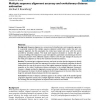Free Online Productivity Tools
i2Speak
i2Symbol
i2OCR
iTex2Img
iWeb2Print
iWeb2Shot
i2Type
iPdf2Split
iPdf2Merge
i2Bopomofo
i2Arabic
i2Style
i2Image
i2PDF
iLatex2Rtf
Sci2ools
110
Voted
BMCBI
2005
2005
Multiple sequence alignment accuracy and evolutionary distance estimation
Background: Sequence alignment is a common tool in bioinformatics and comparative genomics. It is generally assumed that multiple sequence alignment yields better results than pair wise sequence alignment, but this assumption has rarely been tested, and never with the control provided by simulation analysis. This study used sequence simulation to examine the gain in accuracy of adding a third sequence to a pair wise alignment, particularly concentrating on how the phylogenetic position of the additional sequence relative to the first pair changes the accuracy of the initial pair's alignment as well as their estimated evolutionary distance. Results: The maximal gain in alignment accuracy was found not when the third sequence is directly intermediate between the initial two sequences, but rather when it perfectly subdivides the branch leading from the root of the tree to one of the original sequences (making it half as close to one sequence as the other). Evolutionary distance esti...
Related Content
| Added | 15 Dec 2010 |
| Updated | 15 Dec 2010 |
| Type | Journal |
| Year | 2005 |
| Where | BMCBI |
| Authors | Michael S. Rosenberg |
Comments (0)

